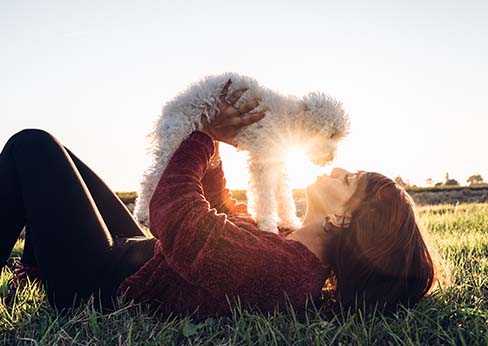In this post:
- What is dominance?
- What role does dominance play in our dogs?
- Do dogs show dominance in human-dog interactions?
- If not “dominance,” then what is the problem?
Is there a sense of dominance between dogs and people? This is a hotly debated topic with people evenly divided into two camps. Some dog owners and animal behavior specialists believe that dogs see every interaction with others in terms of dominant and submissive, or leader and follower. Then there are others who believe when we base our relationship with dogs on the idea that we need to be the ‘leader of the pack,’ we only increase the chances of confrontational exchanges, which can result in aggressive behaviors in the dog.
What is dominance?
Before we dive into this debate, we need to define the concept of dominance. Dominance is usually displayed by pack animals in the wild in order to create social order. This typically happens when there are limited resources, and decisions need to be made on who gets access to things like food and water first. However, if there are plenty of resources available, there is no need for dominant behavior.
What role does dominance play in our dogs?
Dominance applies to domesticated dogs because virtually all species of animals have to have some way to manage limited resources. However, if a dog is provided with sufficient food, water, and attention, there will be no need for them to display dominant behaviors.
Many dogs who are diagnosed as being dominant are actually poorly trained. The problem with assigning dominance to every unruly training case is that you could be missing out on a more significant issue like anxiety, illness, or just inappropriate behavior.
Here is a fantastic example from Dr. Sophia Yin “…there’s the case of my naughty Jack Russell Terrier, Jonesy. When I first got him at eight months of age and introduced him to my parent’s Scottie Maggie and my Australian Cattle Dog Zoe, he immediately tried to mount them. … If Jonesy, who was already neutered, were trying to establish high dominance rank, then when the others snapped at him to go away, he would have fought back. What he did instead was to bounce around and play bow. His mounting behavior was inappropriate to play behavior. … So the trait he was exhibiting was that he was socially inept.”
This example illustrates that many behaviors typically diagnosed as displays of dominance (walking ahead, getting on furniture, and mouthing) are usually something else.
Do dogs show dominance in human-dog interactions?
We have co-evolved alongside dogs and have formed a mutually beneficial relationship that is based on cooperation. The belief that humans can act like a wolf or a dog in order to exert dominance is simply wrong. In most cases, the dog only becomes confused, thinks they’re being attacked, or becomes fearful of their owner. In turn, dog owners can confuse nervous or anxious aggressiveness as dominant behavior in their dogs. If your dog exhibits these behaviors to protect themselves and to communicate their emotional state, not to show dominance over you.
There is another side to dominance behaviors in wolves that we have only recently learned about. In the wild, wolves do not gain their high rank by fighting their way to the top. Instead, a male and female will partner together to breed and create a pack that is more of a family unit, comprised of the parents and their offspring. The parents naturally become the leaders, and the offspring usually follow their lead. As a result of this discovery regarding pack structure, wolf biologists no longer even use the term “alpha” when researching and discussing wild wolf packs.
If not “dominance,” then what is the problem?
Probably 80% of the cases of aggression that people experience have to do with anxiety. Anxiety is the major aggression problem in dogs and the one that we have to work on the most to fix.
According to APDT: Dogs that use aggression to “get what they want” are not displaying dominance, but rather anxiety-based behaviors, which will only increase if they’re faced with verbal and/or physical threats from their human owners. Basing one’s interaction with their dog on dominance is harmful to the dog-human relationship. It leads to further stress, anxiety, and aggression from the dog, as well as the owner’s fear and antipathy.
With anxiety, it is crucial that proper training techniques be used to solve any underlying problems. Work closely with a professional behavioral consultant or professional positive reinforcement trainer to get the results you are looking for. You can check out some in our “Find a Pet Pro” section or reach out to us directly!
Special thanks to:
Dr. James C. Ha, Ph.D., CAAB
Dr. James C. Ha, Ph.D., CAAB is a professor of applied animal behavior at the University of WA and a certified applied animal behaviorist with over 30 years of experience in animal behavior teaching, research, consulting, and expert witness services. Aly was privileged enough to be in his Applied Animal Behavior Certification program.
Discovery Wildlife Park
Discovery Wildlife Park is a refuge for orphaned and unwanted wildlife. They provide “forever” homes for animals who are not able to be returned to the wild. It is located on a 90-acre park with over 30 species of orphaned animals. They offer many family fun adventures from visiting the animals in their zoo to camping.





